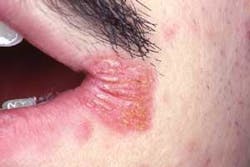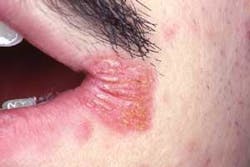Case #8
by Joen Iannucci Haring
A 28-year-old male visited a dental office for an annual check-up. Extraoral examination revealed a crusted area near the corner of his mouth.
History
The patient was aware of the lesion on his facial skin and stated that the crust had been present for less than one week. The patient described the area as "itchy" and commented that he was currently using an over-the-counter Benadryl® cream to relieve the itching symptom. When questioned about his last medical visit, the patient stated that he was last seen by a physician several months earlier for the treatment of an upper respiratory infection.
The patient appeared to be in a general good state of health, with no significant medical history. The patient's dental history included regular examinations and routine dental treatment. At the time of the dental appointment, the patient was not taking medications of any kind.
Examination
Intraoral examination revealed no significant positive findings. Extraoral examination of the head and neck region revealed a brownish crust on the skin of the face adjacent to, but not involving, the commissure of the lips (see photo). Several enlarged and tender lymph nodes were detected upon palpation. No other lesions were noted during the extraoral examination.
Clinical diagnosis
Based on the clinical information available, which one of the following is the most likely diagnosis?
o allergic reaction
o recurrent herpes infection
o herpes zoster
o angular cheilitis
o impetigo
Diagnosis
o impetigo
Discusssion
Impetigo is a superficial bacterial infection of the skin caused by Streptococcus pyogenes and/or Staphylococcus aureus. This bacterial infection is associated with non-intact skin and often involves areas of dermatitis, cuts, abrasions, and insect bites; intact skin is not involved. Impetigo is transmitted through skin contact. Infection results when bacteria enter the skin via insect bites or other traumatized areas. Impetigo is typically seen in children and can occur in epidemics. Outbreaks are associated with poor personal hygiene, crowded living conditions and hot, humid climates.
Clinical features
Impetigo is most often seen on the skin of the face and extremities and does not involve the lips or oral cavity. This infection first appears as vesicles and pustules on an erythematous base. The vesicles and pustules are often pruritic. When the patient scratches these pruritic lesions, rupture results and the liquid contents are released. As the liquid contents dry, yellowish brown crusts (often referred to as "honey colored") are formed. Although regional lymphadenopathy is often seen in association with impetigo, systemic symptoms (fever, for example) are not.
Diagnosis
Impetigo is often diagnosed on a clinical basis and does not require special testing. In instances where the diagnosis is not clinically obvious, a definitive diagnosis may be established via culture of the involved skin.
Treatment
If impetigo is suspected, the patient should be referred to a physician for treatment. Treatment is indicated to relieve symptoms, halt the formation of new lesions, and prevent infection complications. Without treatment, the lesions often enlarge slowly and spread. A topical antibiotic such as mupirocin (Bactroban) is used to treat impetigo and must be applied to the affected area t.i.d. (three times per day) for one week. In severe cases, systemic antibiotics may be indicated.
Joen Iannucci Haring, DDS, MS, is a professor of clinical dentistry, Section of Primary Care, The Ohio State University College of Dentistry.

